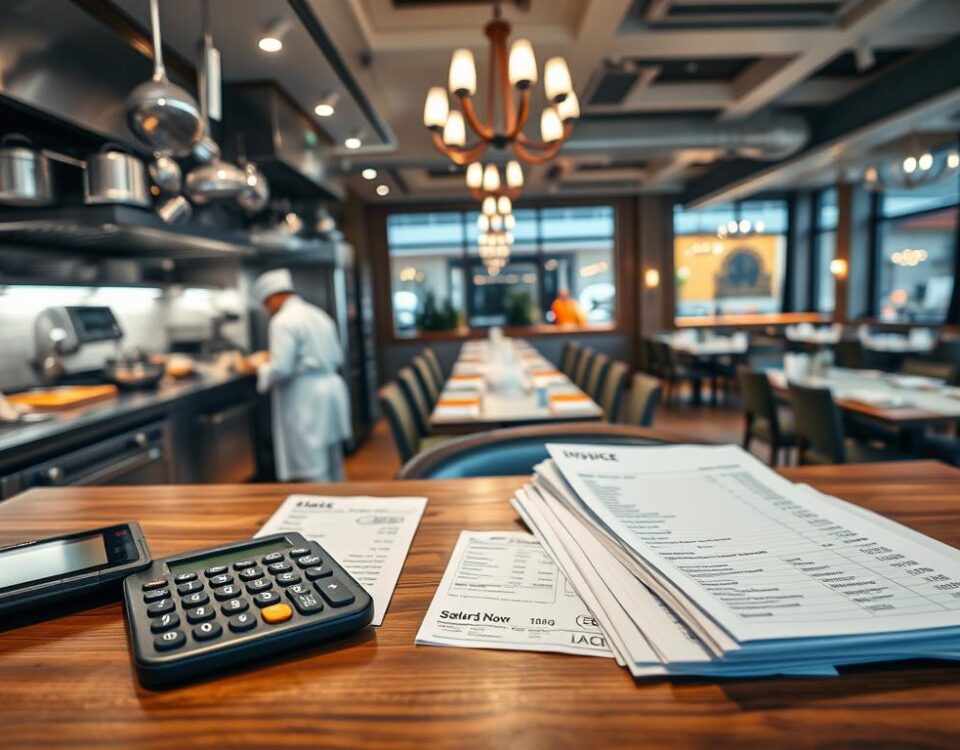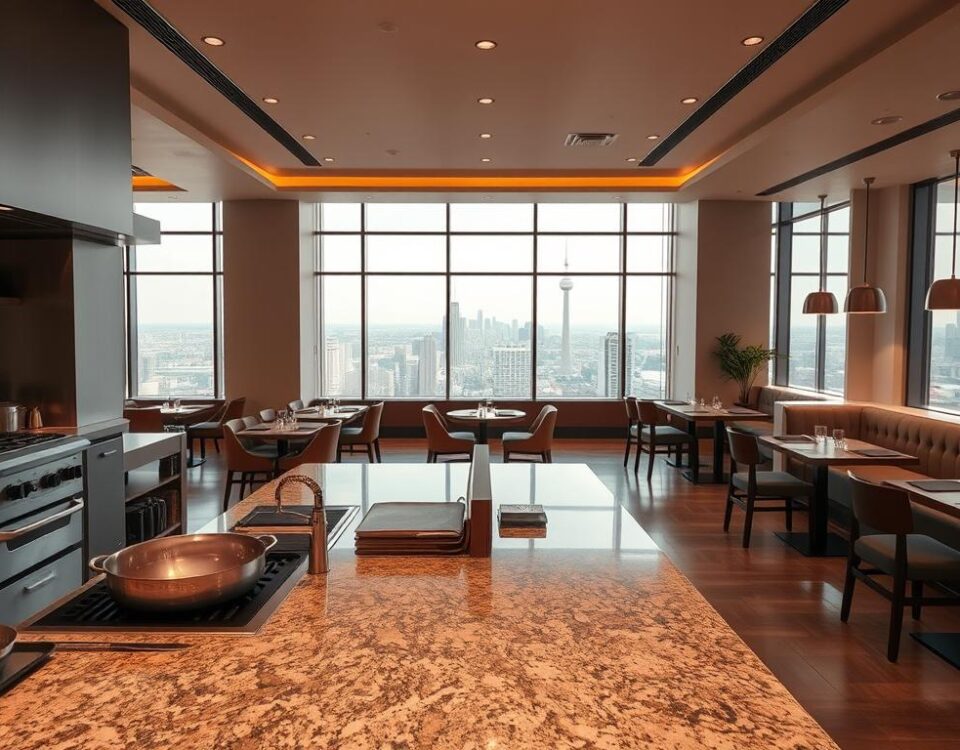
Cost to Open a Restaurant: Quick Calculator and Budget Guide
October 8, 2025
6 Hidden Secrets to Triple Engagement on Your Restaurant’s Instagram
October 9, 2025Imagine having a clear roadmap to success for your restaurant venture. A well-crafted business plan is more than just a document; it’s a guide that helps you navigate the challenges of the industry. Unfortunately, many restaurants fail to make it past the first year, with about 26% closing their doors due to lack of planning and foresight.
As someone who has helped numerous restaurant entrepreneurs secure funding quickly, I’ve seen firsthand the impact a solid business plan can have. My comprehensive guide provides a restaurant business plan template that breaks down the complex process into manageable sections, covering everything from concept development to financial projections.
Are you ready to turn your restaurant vision into a compelling document that attracts investors and secures funding fast?
Key Takeaways
- Create a professional business plan that serves as a roadmap for your restaurant’s success.
- Learn how to present information in a way that resonates with potential investors.
- Highlight your restaurant’s unique selling points and competitive advantages.
- Secure funding quickly with a well-crafted business plan.
- Use a comprehensive guide to develop a business plan that inspires confidence in your vision.
Why Your Restaurant Needs a Solid Business Plan
The restaurant business is fraught with challenges, but a solid business plan can be the key to overcoming them. A well-crafted restaurant business plan serves as a roadmap, guiding you through the complexities of launching and running a successful restaurant.
The Link Between Planning and Restaurant Success
Restaurants with solid business plans are more likely to secure funding and stay operational beyond the critical first two years. A comprehensive business plan clarifies your vision, identifies potential challenges, and outlines solutions, demonstrating to investors that you’ve thought through all aspects of your business.
| Benefits of a Business Plan | Impact on Restaurant Success |
|---|---|
| Clarifies Vision | Increased focus on goals |
| Identifies Challenges | Proactive problem-solving |
| Outlines Solutions | Improved decision-making |
How a Business Plan Accelerates Funding
A comprehensive restaurant business plan accelerates the funding process by anticipating and addressing investors’ concerns before they’re even raised. This proactive approach can significantly reduce the time between pitching your concept and receiving funding.
By following a proven plan template, you can create a persuasive document that builds investor confidence in your concept. This, in turn, can lead to faster funding and a successful restaurant launch.
Creating a Compelling Executive Summary
An effective executive summary is the cornerstone of your restaurant business plan, providing a concise overview that can make or break investor interest. This critical section should encapsulate the essence of your restaurant concept, mission, and financial projections, enticing readers to delve deeper into your business plan.
Crafting Your Restaurant’s Mission Statement
Your mission statement serves as the foundation of your restaurant’s identity, communicating its purpose and values to both investors and customers. A well-crafted mission statement is concise, yet impactful, providing a clear direction for your business. It should resonate with your target audience and reflect the unique aspects of your restaurant.
Outlining Your Concept and Execution Strategy
Clearly outlining your restaurant concept and execution strategy is vital to demonstrating your operational expertise and vision to potential investors. This involves detailing your restaurant’s unique selling proposition, target demographic, and the overall dining experience you aim to provide. By presenting a coherent and compelling strategy, you can instill confidence in your ability to successfully execute your business plan.

Financial Highlights That Attract Investors
To capture investor interest, your executive summary must include key financial highlights that demonstrate the potential return on investment. This includes projected revenue, startup costs, and a break-even analysis. Presenting a clear and realistic financial outlook can significantly enhance your credibility and make your business plan more attractive to investors.
| Financial Metric | Projected Value | Timeline |
|---|---|---|
| Startup Costs | $500,000 | 0-3 months |
| Projected Revenue (First Year) | $1,200,000 | 0-12 months |
| Break-Even Point | 6 months | After Opening |
By incorporating these elements into your executive summary, you can create a compelling narrative that not only captures the essence of your restaurant business but also resonates with potential investors, ultimately enhancing your chances of securing the necessary funding.
Developing Your Restaurant Business Plan Template

Developing a comprehensive restaurant business plan template can make all the difference in turning your concept into a reality. A well-structured template serves as a foundation for your business, outlining key elements that investors look for when making funding decisions.
Essential Components Every Plan Must Include
Every restaurant business plan must include several essential components. These include an executive summary, market analysis, menu development, operations and management structure, marketing and customer acquisition plan, and financial projections. Each section plays a crucial role in demonstrating the viability and potential of your restaurant concept. By including these elements, you can create a comprehensive plan that showcases your vision and strategy.
Customizing Templates to Match Your Vision
While standard templates provide a good starting point, it’s essential to customize them to reflect your unique vision and concept. This involves tailoring your plan to highlight the distinctive features and strengths of your restaurant. By doing so, you can differentiate your proposal from generic plans and make it more compelling to investors.
Digital vs. Print Formats: What Works Best for Investors
The format of your business plan can significantly impact how it is received by investors. While some prefer digital formats for their ease of access and sharing, others may favor print formats for their tangibility and presentation. Understanding your target investors’ preferences can help you optimize your plan’s format and presentation.
By considering these factors and creating a well-structured, comprehensive restaurant business plan template, you can increase your chances of securing funding and turning your restaurant concept into a successful reality.
Menu Development and Pricing Strategy
A well-designed menu is more than just a list of dishes; it’s a strategic tool that showcases your restaurant’s concept and pricing strategy. When investors review your business plan, your menu gives them a clear understanding of what your restaurant offers and how it differentiates from competitors.
Creating a Sample Menu That Impresses Investors
To create a sample menu that impresses investors, focus on dishes that are both appealing to your target customers and profitable for your business. Menu descriptions should be short but evocative, using words that help customers understand exactly what they’ll be eating. For example, “succulent tea-smoked duck with anise-scented plum sauce” is more enticing than simply “duck with plum sauce.”
Food Cost Calculations and Profit Margins
Understanding food costs and setting the right prices is crucial for maintaining healthy profit margins. I’ll guide you through proven formulas for calculating food costs and setting prices that are competitive in your market. Here’s a simple table to illustrate how to calculate food costs:
| Menu Item | Cost per Serving | Selling Price | Profit Margin |
|---|---|---|---|
| Tea-Smoked Duck | $6.50 | $22.00 | 70% |
| Pasta Primavera | $4.25 | $16.00 | 73% |
Menu Psychology and Design Elements
The design of your menu can significantly impact customer choices. Item placement, descriptive language, and pricing strategies are all psychological elements that can maximize revenue. By understanding these principles, you can create a menu that not only showcases your dishes but also drives sales.
Operations and Management Structure
As I dive into the world of restaurant management, I realize that a solid operations plan is the backbone of any successful eatery. A well-structured operations and management plan is crucial for the success of any restaurant business. In this section, we’ll explore the key elements that make up this critical component of your business plan.
Building Your Dream Team
Investors often fund the team as much as the concept, so it’s essential to present your management structure in a way that highlights relevant experience and demonstrates your ability to build and lead an effective team. To do this, you’ll need to flesh out your management team, showcasing the combined work experience and strengths of your key team members. By highlighting their experience and expertise, you can build investor confidence and demonstrate that you have the operational expertise to execute your vision successfully.

Restaurant Design and Layout Considerations
The design and layout of your restaurant play a critical role in supporting efficient operations while enhancing the customer experience. When outlining your restaurant’s design and layout considerations, be sure to highlight how they will contribute to a positive service experience. This includes factors such as seating capacity, kitchen layout, and workflow. By carefully planning your restaurant’s design, you can create an environment that is both functional and welcoming.
Day-to-Day Operational Procedures
Documenting your day-to-day operational procedures is essential for demonstrating your understanding of restaurant management and attention to detail. This includes outlining tasks such as inventory management, staff scheduling, and customer service protocols. By having a clear operations plan in place, you can ensure that your restaurant runs smoothly and efficiently, even during peak periods.
By following these guidelines, you can create a comprehensive business plan that showcases your restaurant’s potential for success. With a solid operations and management structure in place, you’ll be well on your way to securing the funding you need to bring your vision to life.
Marketing and Customer Acquisition Plan
A strategic marketing plan is the backbone of any successful restaurant, providing a clear path to attracting and retaining customers. To convince investors of your restaurant’s potential, you need to demonstrate a thorough understanding of how to market your business effectively.
Pre-Opening Marketing Strategies
Before your restaurant opens, it’s crucial to generate buzz and excitement. This can be achieved through social media campaigns, influencer partnerships, and local press coverage. For instance, you can create a social media contest where followers can win a free meal or a behind-the-scenes tour of your kitchen. Effective pre-opening marketing strategies can create a loyal customer base even before your grand opening.
Digital Presence and Social Media Planning
In today’s digital age, having a strong online presence is vital. This includes a well-designed website, active social media profiles, and a robust online review management system. Your website should be user-friendly, with clear menus, reservation options, and contact information. Engaging content on social media can significantly boost your visibility and attract new customers. Some key strategies include:
- Posting regular updates and promotions
- Utilizing Instagram-friendly food presentation
- Engaging with followers through comments and direct messages
Customer Retention Tactics
Retaining customers is just as important as acquiring new ones. Implementing customer retention programs can encourage repeat visits and build a loyal customer base. Strategies include loyalty programs, personalized marketing, and exceptional customer service. For example, you can offer a loyalty program that rewards customers with points for every dollar spent, redeemable for free menu items or discounts. 
By focusing on these key areas, you can develop a comprehensive marketing plan that not only attracts customers but also keeps them coming back. This, in turn, will demonstrate to investors that your restaurant is a viable and profitable business venture.
Financial Projections That Win Over Investors
Investors rely heavily on financial projections to assess the potential return on investment in your restaurant. A well-crafted financial projection not only demonstrates your understanding of the business but also showcases your ability to manage finances effectively.
Startup Costs and Capital Requirements
To create a comprehensive financial plan, you need to accurately estimate your startup costs and capital requirements. This includes expenses such as construction, equipment, pre-opening marketing, and working capital. Hiring a trained accountant can be beneficial in getting a realistic insight into these costs.
Some key factors to consider when estimating startup costs include:
- Construction and renovation expenses
- Equipment and furniture costs
- Pre-opening marketing and advertising expenses
- Initial inventory and supplies
Creating Realistic Revenue Forecasts
Developing realistic revenue forecasts is crucial for demonstrating the viability of your restaurant. This involves analyzing factors such as seating capacity, table turnover rates, average check size, and occupancy projections. A thorough analysis will help you create a reliable financial projection that investors can trust.
To create a realistic revenue forecast, consider the following:
- Seating capacity and table turnover rates
- Average check size and pricing strategy
- Occupancy projections and seasonal fluctuations
Break-Even Analysis and ROI Timeline
A break-even analysis is essential for determining when your restaurant will become profitable. This involves calculating the point at which your revenue equals your total fixed and variable costs. Additionally, providing a return on investment (ROI) timeline helps investors understand when they can expect returns on their investment.
| Year | Revenue | Expenses | Profit/Loss |
|---|---|---|---|
| 1 | $500,000 | $450,000 | $50,000 |
| 2 | $550,000 | $480,000 | $70,000 |
| 3 | $600,000 | $520,000 | $80,000 |
By presenting a comprehensive financial projection, including startup costs, revenue forecasts, and break-even analysis, you can demonstrate to investors that your restaurant business is a viable and profitable venture.
Conclusion: Turning Your Plan into Funding Reality
As you finalize your restaurant business plan, you’ll be better equipped to navigate the challenges of the industry. A well-crafted plan is the backbone of your restaurant’s success, providing clarity on everything from the concept to the customer experience. By following the business plan template and strategies outlined in this guide, you’ll be well on your way to securing funding and achieving your goals.
Remember, your business plan is a living document that should evolve with your business. Regularly updating it will ensure you stay on track and adapt to new opportunities and challenges in the industry.
FAQ
What makes a restaurant concept successful?
A successful concept is one that resonates with the target market, offers a unique dining experience, and is supported by a solid executive summary that outlines the mission statement and overall vision.
How do I create a marketing plan that attracts customers?
To create an effective marketing plan, I focus on identifying my target customers, understanding their needs, and developing strategies that cater to those needs, including pre-opening marketing and digital presence.
What are the key elements of a financial plan?
A comprehensive financial plan includes startup costs, revenue forecasts, and a break-even analysis, providing a clear picture of the financial viability of my restaurant and helping me secure investors.
How do I determine the ideal location for my restaurant?
To determine the ideal location, I conduct a market analysis to understand the demographics, foot traffic, and competition in the area, ensuring that my restaurant is well-positioned to attract and retain customers.
What is the importance of a menu development strategy?
A well-crafted menu development strategy is crucial as it not only showcases my restaurant’s unique offerings but also helps in food cost calculations and profit margins, ultimately influencing the overall customer experience.
How can I ensure my restaurant’s operations run smoothly?
To ensure smooth operations, I focus on building a strong management structure, defining day-to-day operational procedures, and investing in restaurant design that enhances the dining experience.
What role does customer retention play in my restaurant’s success?
Customer retention is vital as it not only reduces acquisition costs but also fosters a loyal customer base, driving repeat business and positive word-of-mouth, which are essential for long-term success.



